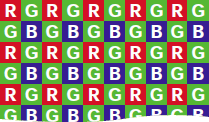Text begins from here.

 |
Digital cameras use the electrical charge produced when light strikes the surface of a CCD to produce a photograph, while film cameras use the light sensitivity of silver halide film. On the surface of the CCD, millions of image receptor photodiodes are grouped to form a dense grid. Each photodiode converts a tiny portion of the overall amount of light in an image into an electrical signal, which provides the image information for a single photograph. |
 |
RGGB array? Interpolation? |
|
The most commonly used CCD color filter array types are RGGB (Bayer pattern), shown in the right figure, and G-added (green-added) patterns. These patterns are used because the human eye is particularly sensitive to green.
* In order to record an image, individual photodiodes are allocated in an "R, G, B" or "R, G, G, B" pattern, which lowers resolution to one-third or one-fourth their original level. As a result, the camera's image processing engine performs an RGB composition and interpolation to create an image with the same number of pixels as the original.
* "RAW format data" is image data taken directly from the photodiodes without performing composition or interpolation.
|
[ Image sensor ]
 |
